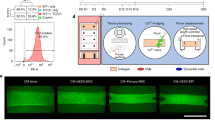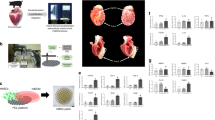Abstract
The concept of an intrinsic regenerative capacity of the adult mammalian myocardium owing to the presence of cardiac stem cells (CSCs) in the atria and ventricles is starting to be accepted by the cardiovascular research community. The identification of this cell population has improved the prospects for developing successful clinical protocols for human myocardial regeneration. In the normal adult myocardium, only a small fraction of CSCs undergo amplification and differentiation to replace the parenchymal cells lost by normal wear and tear. Physiological or pathological stimuli cause substantial activation of CSCs, which is mediated by a paracrine feedback loop between myocytes and CSCs. In response to stress, the myocytes produce growth factors and cytokines, for which CSCs have receptors, and autocrine, self-sustaining activation of growth-factor production is simultaneously triggered in the CSCs. These findings from human and animal studies led us to test whether in situ activation of CSCs by growth factors would be as effective as transplantation of CSCs into the regenerating myocardium after ischemia in an animal model that has relevance to humans. In a porcine model, we produced extensive and functionally relevant myocardial regeneration. Here, we discuss the properties of endogenous myocardial stem cells that might be exploited to produce clinical myocardial regeneration without the need for cell transplantation.
Key Points
-
The adult mammalian heart exhibits a substantial regenerative capacity, which is derived from resident cardiac stem cells (CSCs)
-
Physiological or pathological stimuli cause substantial activation of CSCs that participate in myocardial remodeling
-
Activation of CSCs during adaptation of the heart to stress is mediated by a paracrine–autocrine feedback loop between myocytes and CSCs
-
In situ activation of CSCs by growth factors in a porcine model, which has relevance to humans, is as effective as transplantation of CSCs into the regenerating myocardium after ischemia
-
The properties of endogenous myocardial stem cells can be exploited to produce myocardial regeneration without the need for cell transplantation
-
For meaningful myocardial regeneration to occur, clinical trials using CSCs must be derived from solid, clean, and reproducible basic science data
This is a preview of subscription content, access via your institution
Access options
Subscribe to this journal
Receive 12 print issues and online access
$209.00 per year
only $17.42 per issue
Buy this article
- Purchase on Springer Link
- Instant access to full article PDF
Prices may be subject to local taxes which are calculated during checkout



Similar content being viewed by others
References
Serruys PW (2006) Fourth annual American College of Cardiology international lecture: a journey in the interventional field. J Am Coll Cardiol 47: 1754–1768
Hunt SA et al. (2005) American College of Cardiology; American Heart Association Task Force on Practice Guidelines; American College of Chest Physicians; International Society for Heart and Lung Transplantation; Heart Rhythm Society. ACC/AHA 2005 Guideline Update for the Diagnosis and Management of Chronic Heart Failure in the Adult: a report of the American College of Cardiology/American Heart Association Task Force on Practice Guidelines (Writing Committee to Update the 2001 Guidelines for the Evaluation and Management of Heart Failure): developed in collaboration with the American College of Chest Physicians and the International Society for Heart and Lung Transplantation: endorsed by the Heart Rhythm Society. Circulation 112: e154–e235
Anversa P and Nadal-Ginard B (2002) Myocyte renewal and ventricular remodelling. Nature 415: 240–243
Dib N et al. (Eds, 2006) Stem Cell Therapy and Tissue Engineering for Cardiovascular Repair from Basic Research to Clinical Applications. New York: Springer
Mendez-Ferrer S et al. (2006) Resident progenitors and bone marrow stem cells in myocardial renewal and repair. Nat Clin Pract Cardiovasc Med 3 (Suppl 1): S83–S89
Dimmeler S et al. (2005) Unchain my heart: the scientific foundations of cardiac repair. J Clin Invest 115: 572–583
Korbling M and Estrov Z (2003) Adult stem cells for tissue repair—a new therapeutic concept? N Engl J Med 349: 570–582
Gage FH (2000) Mammalian neural stem cells. Science 287: 1433–1438
Beltrami AP et al. (2003) Adult cardiac stem cells are multipotent and support myocardial regeneration. Cell 114: 763–776
Oh H et al. (2003) Cardiac progenitor cells from adult myocardium: homing, differentiation, and fusion after infarction. Proc Natl Acad Sci USA 100: 12313–12318
Matsuura K et al. (2004) Adult cardiac Sca-1-positive cells differentiate into beating cardiomyocytes. J Biol Chem 279: 11384–11391
Martin CM et al. (2004) Persistent expression of the ATP-binding cassette transporter, Abcg2, identifies cardiac SP cells in the developing and adult heart. Dev Biol 265: 262–275
Messina E et al. (2004) Isolation and expansion of adult cardiac stem cells from human and murine heart. Circ Res 95: 911–921
Laugwitz KL et al. (2005) Postnatal isl1+ cardioblasts enter fully differentiated cardiomyocyte lineages. Nature 433: 647–653
Pfister O et al. (2005) CD31− but not CD31+ cardiac side population cells exhibit functional cardiomyogenic differentiation. Circ Res 97: 52–61
Tomita Y et al. (2005) Cardiac neural crest cells contribute to the dormant multipotent stem cell in the mammalian heart. J Cell Biol 170: 1135–1146
Ellison GM et al. (2006) The pig heart harbors cardiac stem-progenitor cells which respond to growth factor stimulation regenerating the infarcted myocardium [abstract]. Eur Heart J 27: 546
Torella D et al. (2005) Cardiac stem and progenitor cell biology for regenerative medicine. Trends Cardiovasc Med 15: 229–236
Nadal-Ginard B et al. (2003) Myocyte death, growth, and regeneration in cardiac hypertrophy and failure. Circ Res 92: 139–150
Torella D et al. Resident cardiac stem cells. Cell Mol Life Sci, in press.
Torella D et al. (2006) Exercise training activates cardiac stem/progenitor cells through the induction of growth factor production by the myocardium [abstract]. Eur Heart J 27: 444
Ellison GM et al. (2006) Myocardial damage induces a growth factor para/autocrine loop in the spared myocytes which fosters cardiac stem cell activation and ensuing myocyte regeneration [abstract]. Circulation 114 II: 298
Torella D et al. (2006) Resident human cardiac stem cells: role in cardiac cellular homeostasis and potential for myocardial regeneration. Nat Clin Pract Cardiovasc Med 3 (Suppl 1): S8–S13
Urbanek K et al. (2005) Cardiac stem cells possess growth factor-receptor systems that after activation regenerate the infarcted myocardium, improving ventricular function and long-term survival. Circ Res 97: 663–673
Linke A et al. (2005) Stem cells in the dog heart are self-renewing, clonogenic, and multipotent and regenerate infarcted myocardium, improving cardiac function. Proc Natl Acad Sci USA 102: 8966–8971
Torella D et al. (2006) Testing regeneration of human myocardium without knowing the identity and the number of effective bone marrow cells transplanted: are the results meaningful? J Am Coll Cardiol 48: 417
Author information
Authors and Affiliations
Corresponding author
Ethics declarations
Competing interests
The authors declare no competing financial interests.
Rights and permissions
About this article
Cite this article
Torella, D., Ellison, G., Karakikes, I. et al. Growth-factor-mediated cardiac stem cell activation in myocardial regeneration. Nat Rev Cardiol 4 (Suppl 1), S46–S51 (2007). https://doi.org/10.1038/ncpcardio0772
Received:
Accepted:
Issue Date:
DOI: https://doi.org/10.1038/ncpcardio0772
This article is cited by
-
Human cardiac progenitor cell activation and regeneration mechanisms: exploring a novel myocardial ischemia/reperfusion in vitro model
Stem Cell Research & Therapy (2019)
-
Combined administration of mesenchymal stem cells overexpressing IGF-1 and HGF enhances neovascularization but moderately improves cardiac regeneration in a porcine model
Stem Cell Research & Therapy (2016)
-
Cardiac progenitor/stem cells on myocardial infarction or ischemic heart disease: what we have known from current research
Heart Failure Reviews (2014)
-
Endocrine Protection of Ischemic Myocardium by FGF21 from the Liver and Adipose Tissue
Scientific Reports (2013)
-
Isolation, Characterization and Differentiation Potential of Cardiac Progenitor Cells in Adult Pigs
Stem Cell Reviews and Reports (2012)



